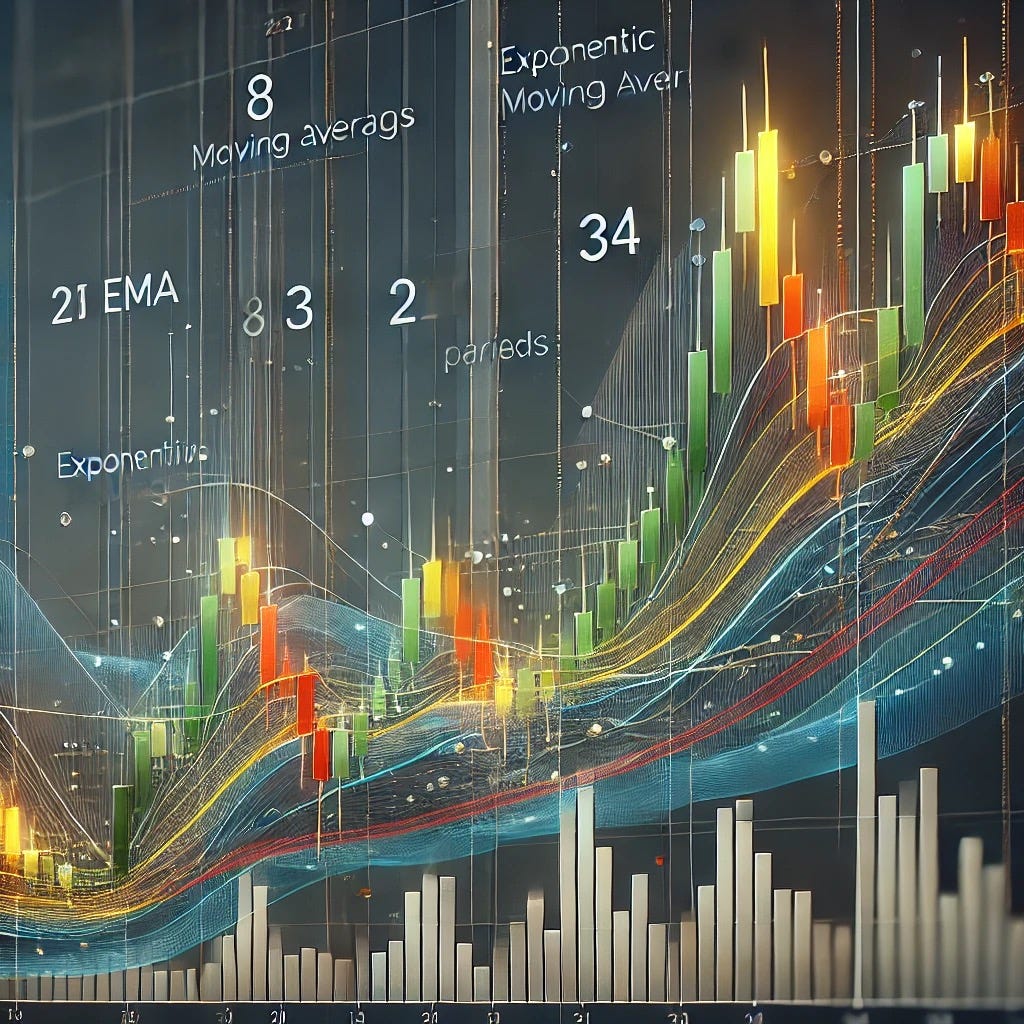EMA Arsenal: How the 8, 13, 21, and 34 Guide My Trades
Every trader has their secret sauce—a combination of tools that give them the confidence to pull the trigger. For me, it’s the 8, 13, 21, and 34 Exponential Moving Averages (EMAs). These numbers may look random, but they’re not. They’re part of the Fibonacci sequence, and they offer a perfect balance of responsiveness and reliability in any market.
In this post, I’ll break down why I use these specific EMAs, how they complement each other, and how you can apply them to your own trading strategy.
Why These EMAs?
The 8, 13, 21, and 34 EMAs are finely tuned to catch short- and medium-term trends. Each serves a specific purpose:
• 8 EMA: My go-to for the immediate trend. This line hugs the price closely and reacts quickly to market changes.
• 13 EMA: A bit slower but still focused on short-term trends. It helps confirm signals from the 8 EMA.
• 21 EMA: The workhorse. This EMA is my filter for the mid-term trend and often acts as dynamic support or resistance.
• 34 EMA: My safety net. It smooths out noise and keeps me anchored to the bigger picture.
Together, they create a layered system that adapts to different timeframes without overwhelming me with conflicting signals.
How I Use the 8, 13, 21, and 34 EMAs
1. Spotting Momentum with Crossovers
I use crossovers to time my entries and exits.
• Bullish Signal: The 8 EMA crosses above the 13 EMA, signaling short-term momentum. If the 21 EMA supports this move, I’m in.
• Bearish Signal: The 8 EMA crosses below the 13 EMA, and the price dips below the 21 EMA. That’s my cue to sell or short.
• Example: Let’s say I’m trading AMD. The 8 EMA crosses above the 13 EMA on the daily chart. The price bounces off the 21 EMA, confirming support. I ride the trend until the 8 EMA crosses back below the 13 EMA.
2. Riding Trends
During a strong trend, the 8 and 13 EMAs act as my “fast lanes,” while the 21 and 34 EMAs serve as my “guardrails.”
• In an uptrend, the price usually pulls back to the 8 or 13 EMA before continuing higher. If it dips to the 21 EMA but holds, the trend is still intact.
• In a downtrend, the 8 EMA becomes resistance, and the 21 EMA confirms the bearish momentum.
3. Dynamic Support and Resistance
I watch how the price interacts with these EMAs:
• Bounces off the 21 or 34 EMA in an uptrend? That’s a buying opportunity.
• Fails to break above the 21 EMA in a downtrend? Time to short.
• Example: I’m watching SPY. The price pulls back to the 21 EMA after a breakout, consolidates, and then resumes its climb. That’s my signal to add
While EMAs are powerful, they’re not standalone indicators. I pair them with other tools for confirmation:
• RSI: Helps me avoid chasing overbought or oversold conditions. For example, if the price is testing the 21 EMA but RSI is in the overbought zone, I hold off on entering until conditions normalize.
• Volume: Validates price movements. A breakout above the 21 EMA with rising volume signals strength and confirms the move. If volume is weak during the breakout, it’s often a fake-out.
• MACD: Confirms momentum shifts when crossovers align with EMA signals. If the MACD histogram flips positive around a bounce off the 34 EMA, it adds confidence to the trade.
• Fibonacci Levels: Identify high-probability retracement zones that align with EMA support or resistance. When a Fibonacci retracement (e.g., 38.2% or 50%) overlaps with the 21 EMA or 34 EMA, it creates a strong confluence zone. I use this as an entry point or stop-loss zone.
• Example: The price retraces to the 50% Fibonacci level, aligning perfectly with the 34 EMA. I wait for a bounce confirmation, like a bullish candlestick or RSI divergence, before entering the trade.
Real-Life Example: My EMA Setup in Action
Let’s break it down with a hypothetical trade:
• Setup: I’m watching TSLA. The 8 EMA is above the 13 EMA, and the price is bouncing off the 21 EMA.
• Signal: A pullback to the 13 EMA holds, and the price starts moving higher with strong volume.
• Action: I enter a long position and set my stop-loss below the 34 EMA.
• Exit: The price crosses below the 13 EMA, signaling that momentum is fading.
Tips for Using the 8, 13, 21, and 34 EMAs
1. Stick to Your Plan: Don’t panic if the price briefly wicks below an EMA. Look for confirmation before acting.
2. Adjust for Timeframes: Use the same EMAs on multiple timeframes. On a 5-minute chart, they’re great for day trading. On a daily chart, they’re perfect for swing trading.
3. Know When to Sit Out: In choppy markets, EMAs lose their edge. If the price isn’t respecting the 21 or 34 EMA, wait for clearer signals.
EMAs Are My Compass
The 8, 13, 21, and 34 EMAs give me clarity in a market full of noise. They help me spot trends, time my entries and exits, and stay disciplined in my trading. They’re not just lines on a chart—they’re my guideposts.
If you’re not already using these EMAs, give them a try. Start by adding them to your chart, watching how the price interacts with each, and building your own strategy around them. Let me know how they work for you—I’m always curious to hear how others trade with the EMA’s




